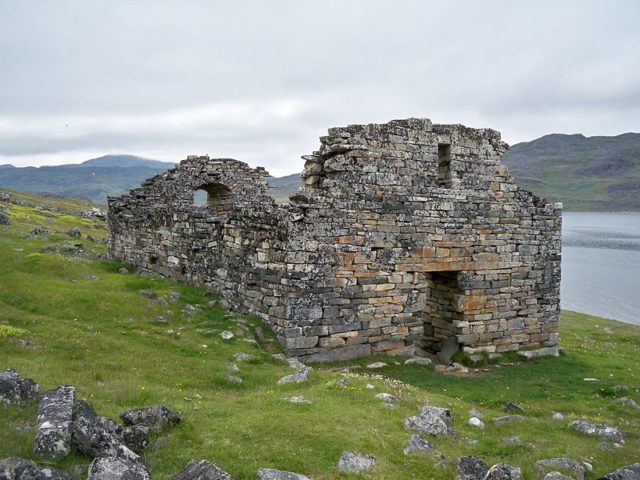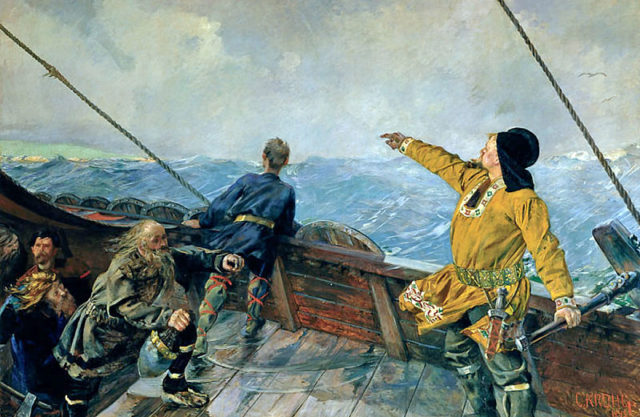A 20th century discovery proposes that the Vikings might have explored North America.
Even though the reason for its presence in Charles Point is contested, no one is able to deny the fact that the Nordic spearhead was found by Augustus Hoffman in 1929.
With very little proof of why or how the artifact came to the Great Lakes region, researchers rely on the legends and ancient tales to help explain the mysteries of the spearhead.
In the summer of 1929 a storm blew through the Great Lakes Region.

This had caused a large deal of property damage to the homes on the shoreline.
Hoffman was one of countless Charles Point residents whose summer homes were demolished by the torrential downpours and heavy winds. As he was starting to rebuild his home, Hoffman found it difficult to get the right terrain for laying his foundation.
Sooner or later, a site around 304.8 meters (1,000 feet) away from the shore was selected and Hoffman started the work of excavating the solid granite in order to lay the foundations.
During the process he found an old relic. It was too big to be an arrowhead but the incorrect form to be a dagger.
He pocketed the artifact, assuming that it was left over from the days when the Native Americans roamed the coasts. But there was something unique about Hoffman’s discovery.
The original weaponry was usually created out of stone; this artifact had been created out of iron and was rusted with age.
Hoffman had brought his discovery into town to the banker of Lyons, Saxon B. Gavitt.
Assuming that Hoffman’s discovery may have some kind of historical value, Gavitt had quickly gotten into contact with James Curran, who was the editor of the Sault Daily Star.
Curran at the time proposed that they send the artifact to specialists at the University of Toronto for examination.
A Norse Spearhead
By 1930, Dr. C.T. Currelly, who was the curator of the Royal Ontario Museum, had pronounced Hoffman’s discovery as an authentic Norse spearhead. This object was most likely made between the 7th and 12th centuries AD.
The artifact that Hoffman discovered measured 23.5 centimeters by 1.75 centimeters (9.25 inches by 0.69 inches).
The handle was 5.23 centimeters by 2.24 centimeters (2.06 inches by 0.88 inches).
It is thought that, in the original form, both the handle and blade could have been bigger. Yet, given the design and iron composition, there is very little doubt that the spearhead was originally created by the Vikings.
Stories from the Sagas
The date of the spearhead is thought to be 600-1100 AD. This would fit with the known time period of the Viking exploration of the North American coastline.
According to the Norse stories, the Vikings first arrived in the New World when Bjarni, who was the son of Herjulf, came upon the beautiful wooded area of present-day Canada.
Leif Erikson and Other Explorers in Vinland

Leif Erikson, son of Eric the Red of Greenland, had been enchanted by the tales of the bountiful land. He set sail from the country of Greenland with a crew of 35 men accompanying him.
Leif was adrift, and he decided to act out the Norse custom of wayward sailorsv-this was to release a raven. It was was known to the Vikings that birds always seek to return to land.
The crew had carefully watched the bird while it was flying off.
If the raven would return, there was no land to be found. Yet, if the bird did not return, that meant it discovered land. This had happened with the raven Leif sent forth – the crew set sail towards the direction they had last seen the raven flying.
In a few hours, they sighted land, though it was not the bountiful land that was described by Bjarni.
It was rather stony land and flat, possibly modern Baffin Island.

They decided to continue to explore the southern coast until they finally came across better land. One place had countless trees, grains, and wild grapes. Leif chose to name this location Vinland.

Even though Leif went back to Greenland, countless other Viking exploration groups went out to explore the New World and had even started a few colonies.
The stories of their voyages are incomplete -today we only have obtained only a few chapters of these rich, ancient stories.
The spearhead discovered by Augustus Hoffman was an ancient Viking artifact discovered farther south than anticipated. Some other relics were found in Ontario, Wisconsin, and Minnesota.
But all of these discoveries are like Hoffman’s, suggesting that the Vikings actually did not explore that far south, but traded their weapons with the local natives instead, Ancient Origins reported.
The books have clearly indicated that the Vikings explored the new land over the summer for many year, although where the Norsemen had actually ventured can’t be known for certain from legends that are remaining today.
Unless a big treasure trove of Norse settlements or artifacts can be discovered, archaeologists will remain unsure about the presence of the Vikings in the U.S.
